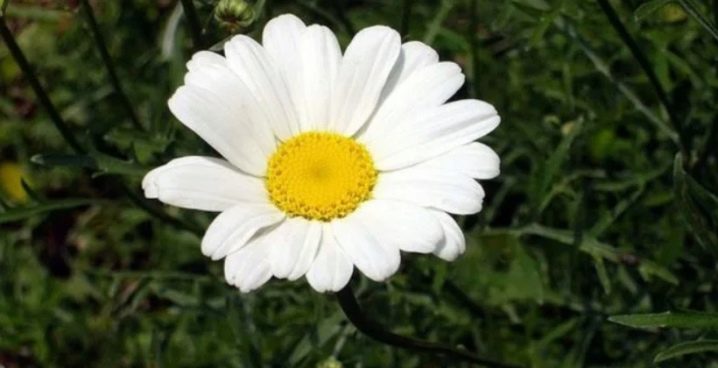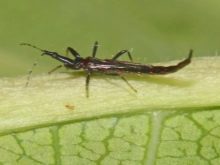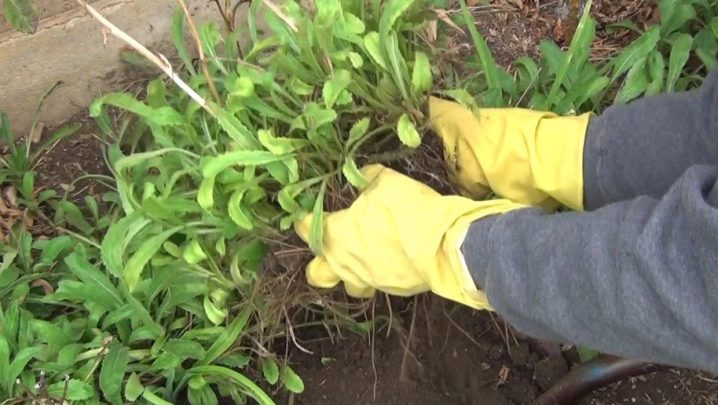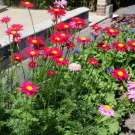All about the Dalmatian daisy

This flower is not rare and unique, but when it appears either on the site, or in a vase, or in a bouquet, it is difficult not to admire its unpretentious beauty. We are talking about Dalmatian chamomile, it is also called Persian, and its other name is pyrethrum. This perennial from the Asteraceae family, of course, is impressively similar to the pharmacy chamomile, which sometimes leads to confusion. But the plants are different, although in the very classification of Dalmatian chamomile there is an internal division, not so simple.
Botanical description
This perennial has a well-developed root system, and the main root of the plant can go deep into the soil even 3 m. And if chamomile grows in a soft arable layer, it can additionally form a developed system of lateral root branches. First, they grow horizontally, and then go down. And at the base of the stems of the Persian chamomile, many adventitious roots will form.


What a perennial plant looks like:
-
has many stems with ribbed edges;
-
the leaves of chamomile are three times pinnately dissected;
-
segments of leaf plates are distinguished by the shape of blades with separate lobes, the tops of the latter are rounded;
-
the underside of the leaves is fleecy, distinguished by a silvery-gray tone;
-
the top side of the leaf depends on the place where the chamomile grows - somewhere it is a rich green color, and somewhere a faded green with a grayish undertone;
-
since the plant has many stems and leaves at the very base, the bush looks dense and thick;
-
flowers are represented by single baskets with white pseudo-ligate marginal flowers and yellow median tubular flowers;
-
the flowers are located on the tops of the stems, they really look like the flowers of a pharmaceutical chamomile, only larger (4-5 cm in diameter, and the flowers of a pharmaceutical chamomile are somewhere in half);
-
this species also has a flat receptacle, that is, a flat core (and in a pharmacy chamomile it is spherical);
-
if the flower is cut vertically, it can be seen that the pyrethrum has no cavity in the receptacle - the pharmacy has it;
-
the fruits of the Persian chamomile are yellow with brown achenes, with longitudinal ribs, about 0.5 cm long, 1 mm wide.


By the way, both daisies are far from sisters, and not even cousins, speaking metaphorically. They are two different species that even belong to different genera.
Greece and Albania are the countries where Dalmatian chamomile is very common in its natural form. And usually you can find it in mountainous areas, on slopes that are well lit by the sun. By the way, Dalmatia is the traditional name of the Balkan countries, which is why such an adjective is applied to this flower. And as a cultural variant, feverfew is widespread in the Crimea, Moldova, and cultivation is also established in Asian countries. In Italy, France and Japan, you can also see huge plantations of Dalmatian chamomile.


Popular types and varieties of pyrethrum
There are perennials (these are almost all species and varieties, except for maiden), but it is better to start the description with an annual representative of pyrethrum.
Maiden
And also it can be called maiden tansy or even maiden chrysanthemum. Chamomile can grow up to half a meter. She has a branched stem and feathery leaves, they can be pale green and yellow. Outwardly, this species is extremely similar to the common chamomile, and it blooms from July to August.
This species has a varietal division.
-
"Golden ball" - not very tall, but cold-resistant flower, resembling a yellow basket, spherical and double. If planted in a flower bed, it will be "fluffy". A bouquet of these plants will stand for a very long time.
-
"Snowball" - reaches 30 cm, grows with a large number of double flowers, which are very reminiscent of pads. Will grow well in a sunny location.
-
"Aureum" - grows in bushes with small flowers, almost ordinary-looking chamomiles, the petals of which have a light lemon shade. Blooms from June to August.
-
"Plenum" - has double weightless flowers, white with a light yellow core.
-
"Carlos" - white flowers with a summer aroma, very simple to care for, cold-resistant. But they are not high, only 15 cm. The flowers are terry, reminiscent of pads.
This type of pyrethrum belongs to annuals.


Pink
This species is often called feathery chrysanthemum or bright red tansy. The flower has a straight stem and dissected, expressive leaves. There are already many varieties of such chamomile, but it cannot be said that they are quite widespread. And the varieties are actually classified simply - low or medium, according to shades - white, but mostly all variations of red, in structure - simple or double. But the most famous variety - "Robinson", which grows in height up to half a meter, often red, but maybe pink in color.
A there are also varieties of "Brenda", "Vanessa", "James Calway" and others. Crimson, red, delicate pink - these are what these romantic flowers are like.
Looks good in bouquets with a lot of yellow color, and where there are plants with a velvety texture.



Large-leaved
And this is the Caucasian representative of the Astrovian. Can grow very tall. It has touching snow-white inflorescences, which, like shields, adorn the bush during flowering. But at the end of the season, the color changes to reddish brown. This species will look especially beautiful in combination with cereals.

Other
And there is a species that is called "beautiful", a low plant with thin needle-like leaves, the flower of which resembles an ordinary chamomile. But this feverfew grows exclusively in the mountains, as it needs rocky soil.
The scale species grows up to 45 cm, light yellow flowers of the plant can also be seen more often in the mountains. Cinerarielous chamomile is more like chamomile than others, because its core is yellow and its petals are white. It is grown in the southern regions, and also in the Far East: the fact is that this species does not tolerate frost, and it needs more favorable conditions.


Landing
If you collect seeds yourself, you will hardly be able to preserve the maternal characteristics of the plant. Therefore, it is better to contact a specialized store, where there is at least some guarantee of getting what is shown on the package. Dalmatian chamomile seeds are very small, in order to facilitate their sowing, you will have to combine them with sand.
Timing
This is usually done in March. But this is for seedlings. And in open ground, you need to plant flowers in May, and before planting, the site, or rather the area for flowers, must be cultivated. The plant will need loose soil, light, weed-free. It is necessary that the landing site be well lit. If water stagnates in the ground, the result is unlikely to be good.
If the soil is acidic, you will have to correct it, add ash or lime. Cultivation usually involves seedlings, but without it, planting flowers in the garden is possible only in the southern regions.

Technology
Planting through seedlings is more transparent or something, it is easier to determine the percentage of seed germination. And the best rooting in the ground is also achieved in this way. And it is very gratifying for gardeners that pre-sowing preparation is not required for seeds, they are sown dry. As already mentioned, mixing them with sand means easier sowing.
Step by step it looks like this.
-
The container is filled with suitable primer.
-
Seeds are scattered over the surface, sprinkling 5 cm of soil.
-
After planting, the surface must be watered and sprayed with a spray bottle.
-
The containers must be covered with film or glass, sent to a bright place.
-
For seeds to germinate, they need a temperature of + 15 ... 18 degrees.
-
You need to expect shoots in 2 weeks or a little less.
-
After the shoots have appeared, you need to remove the glass or film.
-
A pick is required, it is carried out when a couple of leaves have appeared on the seedlings.



But the seedlings will go to open ground in May. To grow feverfew, you need to save it from being in constant shade or partial shade. In this place, the plant is either completely oppressed, or too stretched out and gives a weak flowering.
Before planting, seedlings must be adapted to outdoor conditions, and taken outside. The seedlings are simply transferred into prepared holes. It is not worth shaking off the earthen lump, with it the plant will take root definitely faster and better. Right after planting, chamomile can just be shaded, because its leaves are still too tender, the active sun can burn them.
Dalmatian chamomile is transplanted either immediately to a permanent place, or you can first to a temporary one. By the way, it serves not only as a decorative element on the site. The fact is that feverfew, if planted next to cabbage, successfully scares away caterpillars. And if it is planted next to fruit trees, the latter will not be afraid of aphids and moths.


Care
The plant is certainly not capricious, even a novice florist will cope with caring for Dalmatian chamomile. Even those who manage in the country for the first year often plant feverfew, because the flower is extremely unpretentious. He is not even afraid of weeds, and those who cannot constantly be on the site will not worry about the absorption of beautiful flowers by the weed. But it is still better to organize weeding: in fact, it is really important only during the growing season. And there is an even more cunning way - you can mulch the soil, and weeding a priori will become rare. It is better to mulch the soil under the chamomile organic matter.
In order for the culture to grow well, it is better not to regret watering it, chamomile responds to it gratefully. After watering, it is better to loosen the ground so that a dense crust does not form on it (it makes it difficult for air to get inside).
In feeding, feverfew is definitely not fussy - organic matter and minerals will be more than enough for it. Only now there is a danger of overfeeding the flowers with nitrogen, otherwise the set of green mass will be excessive, and then the flowering will become poor at all. Dalmatian chamomile, by the way, reacts very well to rotted manure.


Shoots that grow tall are not the strongest, and therefore it is better to tie them up. As soon as the chamomile fades for the first time, you need to remove all flower stalks, without waiting for the moment of grain formation. And then at the end of summer, the bush will delight you with repeated flowering.
Four years in one place is the optimal period for feverfew, then it is better to transplant the plant to a new place. During this time, the culture grows strongly, it becomes cramped, hence the impoverishment of flowering. By the way, when transplanting, the plant can be successfully divided.


And a little more about protecting a flower from habitual misfortunes:
-
this plant is distinguished by good immunity, but occasionally pathogens can also affect it;
-
fusarium or gray rot - this is what is especially dangerous for chamomile, diseased fragments of the bush must be removed and removed from the site, it is no longer possible to save them;
-
the place from which the affected flowers were removed must be disinfected with a fungicide solution.
The flower can be attacked by thrips, slugs, aphids. Slugs are harvested by hand, there is no administration for thrips (but after removing the affected plants, the land must be thoroughly treated with insecticides). Insecticides are also used for aphids, and the treatment should be repeated once or twice.
But diseases and insects do not attack the flower as often, as the plant as a whole is rarely troublesome.



Reproduction
And here there are several options, each can be successful. You can propagate the Persian chamomile in different ways.
Seeds
This is a method with seedlings and their subsequent planting in the ground, which was described above.

By dividing the bushes
As soon as flowering is over, the old bush is dug up. The soil from the roots is certainly shaken off, you can even rinse the roots. The bush is divided into sockets, after which they are planted separately from each other. Caring for new bushes is the same as for an adult specimen. The division is usually carried out every two years (or even three), and this is an important point in the rejuvenation of the bushes.

Cuttings
Young near-root shoots will be cuttings that successfully help feverfew to multiply. They can be rooted in the summer at any time, be sure to shade and cover with a film. This will not let the youngsters dry up.
Reproduction by seeds collected from their own flowers is a good option, but only if the gardener is ready for new options for the color of Dalmatian chamomile. But the preservation of the trait of the variety requires reproduction in other ways.

By the way, Another big plus of feverfew is that this flower is very friendly. This means that it will peacefully coexist with other plants in the garden, in flower beds. And it will look very good. For example, Matricaria (maiden chamomile) looks great with carnations and foxgloves. And also tanacetum - this is also the name of the plant - goes well with bells. For discounts and mixborders, this is all a very good option.
And if someone wants to create a trendy, up-to-date garden, you need to take a closer look at the country style. And in it, the Dalmatian chamomile occupies one of the most obvious places. A flower bush will look great under the trees, near which it perfectly takes root. In a word, a "pliable", beautiful and comfortable flower in terms of care.













































































































The comment was sent successfully.